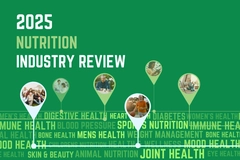
- Industry news
Industry news
Trending now
- Category news
- Reports
Trending now
- Key trends
Trending now
- Multimedia
Multimedia
Trending now
- Journal
- Events
Trending now
- Suppliers
Suppliers
Trending now
- Home
- Industry news
Industry news
Trending now
- Category news
- Reports
Trending now
- Key trends
Trending now
- Multimedia
Multimedia
Trending now
- Events
Trending now
- Suppliers
Suppliers
Trending now
Consumers Need to Increase Their Focus on Essential Nutrients

Information on a balanced diet should teach consumers to make a positive choice in favour of beneficial, essential nutrients when selecting food.
22/10/07 Food information providers should do more to advise consumers on what they should be eating rather than overemphasising what they shouldn’t. By only talking about saturated fats, sugar and salt, they risk ignoring essential nutrients such as proteins, vitamins and minerals, Toon van Hooijdonk warned today on assuming the Special Chair in Dairy Science and Technology at Wageningen University. Professor Van Hooijdonk is Corporate Director of Science & Research at Campina.
The professor added that this one-sided message on nutrition was also failing to highlight the benefits of dairy foods, since milk contains many healthy and essential nutrients which many people won’t be getting in sufficient amounts from other products. In his inaugural address ‘Milk: from farm to fitness’ ('Melk: van grond tot gezond'), Van Hooijdonk argued that a decline in the consumption of dairy products would be detrimental to public health. ‘Information on a balanced diet should teach consumers to make a positive choice in favour of beneficial, essential nutrients when selecting food. It would be useful if we could have an analysis of the health effects of dairy for the Dutch population, like the one the National Institute for Public Health and the Environment (RIVM) produced on vegetables and fruit.’
Differences between saturated fatty acids
To improve nutrition, it is important to find ways of reducing levels of harmful saturated fatty acids. Work is being done in various places to change the composition of fatty acids in milk. One way is by changing the composition of the feed given to dairy herds. But Van Hooijdonk maintains that by no means all saturated fatty acids should be regarded as unhealthy. The idea that all saturated fatty acids are bad for you isn’t accurate, he argues. ‘Milk does contain bad saturated fatty acids which increase cholesterol levels. But it also contains saturated fatty acids that aren’t risky. Yet from what some people are saying, you’d expect the consumption of milk to involve a higher risk of cardiovascular disease. Epidemiological research shows this simply isn’t the case. Clearly, other nutrients in milk are offsetting that effect.’
Sustainability
Professor Van Hooijdonk also believes that sustainability is now one of the biggest challenges facing the dairy sector, with climate control and animal welfare the key themes. He maintains that the dairy industry should be able to generate a high proportion of its own energy requirements from the fermentation of manure. The advent of biofuel production also means that new residual flows, such as rape seed husks, can be used as a basis for cattle feed. Additional research will be needed on the effects of such changes on milk quality and food safety. More attention for the health and welfare of cows is a further prerequisite, according to Van Hooijdonk.
Specialisation
The growing specialisation in dairy farming and processing also interests Professor Van Hooijdonk. He predicts that in future, dairy farmers won’t just be making a distinction between how businesses are run (such as organic versus non-organic dairy farming), but also between the composition of milk, depending on how it is going to be processed or what end product it is destined for.










